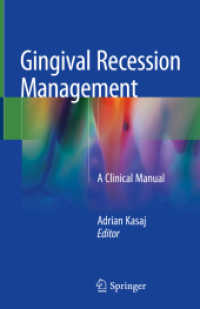Full Description
"He who is faithfully analysing ... epi lepsy is doing far more than studying epilepsy" Hughlings Jackson Modifying this well-known statement by Jackson, one could say today: "He who is faithfully analysing anti-epileptic drugs is doing far more than studying anti-epileptic drugs". For these drugs not only serve to prevent epileptic fits and thus advance the treatment of epilepsy, they are also effective in the treatment of cardiac arrhythmias and trigeminal neuralgia. Furthermore, clinical pharmacologists consider anti-epi leptic drugs as model drugs in pharmacokinetics and pharmocodynamics, since reliable methods are available for their determination and their effects and side effects can be defined. The methods of estimating of drugs in body fluids provide a tool that enables us to throw light on many obscure relationships in pharmaceutical treatment. Now that we can study the pharmacokinetics and interaction of drugs in man, many hypotheses based on clinical experience alone may well be eliminated or corroborated. The grow ing body of knowledge will make us more careful about the administration of drugs in combination. Now that we can study how biological parameters interfere with drug action, we may perhaps proceed to the scientific analysis of many clinical observations that suggest the importance of such factors as age, sex, menstrual cycle, pregnancy, fever, diet, stress, sport, climate, and altitude.
Contents
A. Pharmacokinetics.- Statistical Analysis of Pharmacokinetic Parameters in Epileptic Patients Chronically Treated with Anti-Epileptic Drugs.- Clinical Pharmacokinetics in Monitoring Chronic Medication with AntiEpileptic Drugs.- Drug Interactions at the Metabolic Level: A Reality in Drug Treatment of Epilepsy.- B. Pharmacology of Anti-Epileptic Drugs.- I. Phenytoin.- Comparison of Gas-Chromatographic and Spectrophotometric Determinations of Phenytoin in Serum.- Serum Levels of Phenytoin in Children.- Problems in Controlled Anti-Epileptic Treatment with Phenytoin in Children.- Longitudinal Studies of Serum Anti-Epileptic Drug Levels. Preliminary Observations: Interaction of Phenytoin and Primidone.- Effect of Drug Therapy on the Metabolism of Phenytoin.- II. Ethotoin.- Plasma Concentrations of Ethotoin in Epileptic Patients.- A Gas Chromatographic Method for the Determination of Ethotoin (3- Ethyl-5-Phenylhydantoin) in Human Plasma.- III. Barbiturates.- Some Problems Concerning the Quantitative Assay of Primidone and Its Metabolites.- Determination of Hydroxymetabolites of Phenobarbitone and Phenytoin.- The Effect of Psychotropic Drugs on Serum Anti-Epileptic Levels in Psychiatric Patients with Seizure Disorders.- IV. Carbamazepine.- Carbamazepine: An Attempt to Correlate Serum Levels with Anti-Epileptic and Side Effects.- Pharmacokinetic Data o£ Carbamazepine and its Major Metabolites in Man.- Pharmacokinetic Studies on Carbamezepine in Volunteers and in Epileptic Patients.- A Preliminary Study of Serum Carbamazepine Levels in Healthy Subjects and in Patients with Epilepsy.- Carbamazepine: The Influence of Other Anti-Epileptic Drugs on its Serum Level.- Drug Interaction in Epileptic Patients.- The Influence of Phenobarbitone and Phenytoin on Carbamazepine SerumLevels.- V. Ethosuximide.- Correlation of Serum Ethosuximide Levels with Clinical Effect.- VI. Dipropylacetate.- Less Usual Ways of Administering Anti-Epileptic Drugs.- Enteric Coated Dipropylacetate (Depakine).- Analytical Data in Connection with the Clinical Use of Di-n-Propylacetate.- VII. Clonazepam.- Clinical Pharmacokinetic Experiences with Clonazepam.- Pharmacokinetics of Clonazepam in Man and Laboratory Animals.- C. Various Aspects (Varia).- Absorption and Protein Binding in Serum of Several Anti-Epileptic Drugs.- Phenytoin and Phenobarbitone Levels in Human Brain and Cerebrospinal Fluid..- D. Quality Control and Standardization.- Report on Worksheets Collected after WODADIBOF I.- Results of a Phenytoin Quality Control Scheme.- The Development of a Matrix Reference Standard for Anti-Epileptic Analysis.- E. Methodology of Determination.- Comparison of Methods for Determination of Drugs in Serum and Plasma.- Application of a Nitrogen-Specific Detector for the Gas Chromatographic Determination of Phenytoin, Primidone and Phenobarbitone in 20 µl Serum..- Consecutive Determination of the Levels of Twelve Anti-Epileptic Drugs in Blood and Cerebrospinal Fluid.- Evaluation of an Experimental Homogeneous Enzyme Immuno-Assay for the Quantitation of Phenytoin and Phenobarbitone in Serum or Plasma.- F. Dictionary of Anti-Epileptic Drug Synonyms, Chemical Names and Nonproprietary Names.- F. Dictionary of Anti-Epileptic Drug Synonyms, Chemical Names and Nonproprietary Names.



![Nomads of Mauritania [Paperback, Premium Color] (Anthropology)](../images/goods/ar/work/imgdatag/16227/1622737253.JPG)




